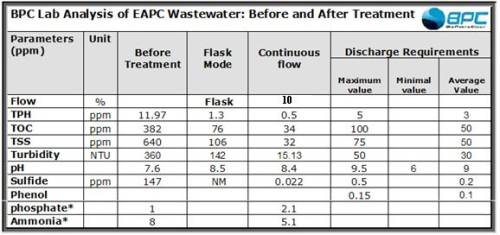
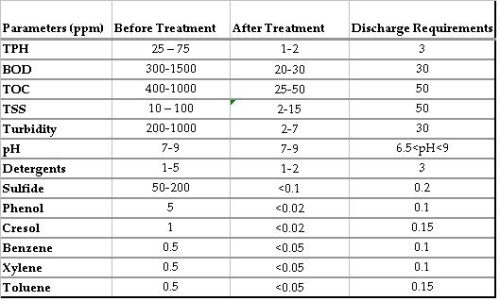
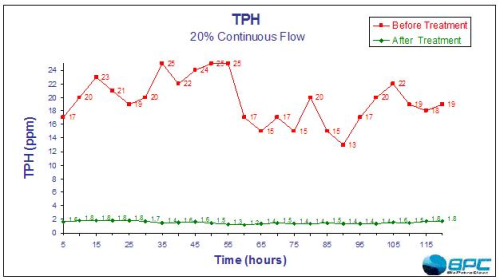
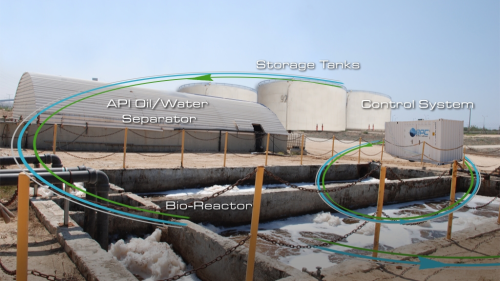
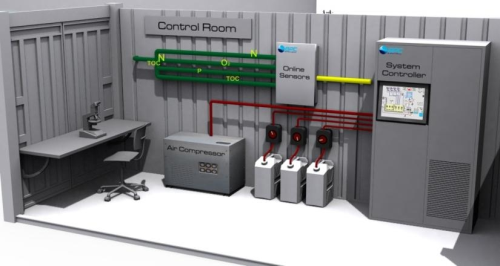
Introduction This article discusses the installation of BioPetroClean’s (BPC) Automatic Chemostat Treatment (ACT) at the Eilat-Ashkelon Pipeline Company (EAPC), following a successful pilot project in 2007. Using a fullyautomated biological skid-mount system, BPC was able to treat drainage and ballast water on-site, utilising existing infrastructure and giving EAPC the ability to improve and control the quality of their waste water.
Background EAPC serves as a land bridge for transporting crude oil between the Red Sea and the Mediterranean, and provides long term storage and crude oil blending. The company produces waste water from storage tanks, feeder pipes from tankers, and runoff rainwater. EAPC’s awareness of environmental issues was heightened by the site’s proximity to a water desalination facility, a nature reserve, and a densely populated civilian area. The company’s former method of drainage and ballast water treatment was based on the use of a gravitational oil separator, following which the inadequately treated water was released into permeation lagoons in close proximity to the shoreline. The treatment flow rate was 5 m³/hour and contained a 4% salinity level. EAPC was having difficulties in adhering to the required environmental standards, and was strongly criticised by members of industry, as well as civilians, for polluting the waters surrounding the terminal.
EAPC sought a cost-effective solution that would bring its wastewater to the highest standards, using less chemicals and electricity.
The solution The BPC solution was implemented using a three phased approach. Feasibility testing and extensive analysis were performed on water samples from the EAPC site at BPC’s laboratory. Based on the results of the analysis, BPC installed a pilot system which operated for a period of six weeks, with specific environmental elements and ground conditions.
Phase 1: lab analysis Automatic Chemostat Treatment (ACT) was performed on EAPC’s water samples by applying a tailored bacterial cocktail to remove all hydrocarbons. The cocktail is comprised of a unique mixture of naturally occurring bacteria that feed on petroleum hydrocarbons and other organic compounds. In order to ensure optimal bio-degradation of the contaminated water, this cocktail is then combined with a proprietary nutrient-mix.
For the purpose of identifying the optimal conditions, a selection of flask treatments were performed under simulated conditions, utilising bacteria from BPC’s “bacterial bank”. Experiments were then conducted in order to determine the optimal treatment process. The results were presented in a detailed report that included comparison values of all measured parameters and associated treatment protocols.
Stage 1: Analysis – A series of laboratory tests (which included bacterial concentration,
TOC, TPH, COD, phenol, UV scan, salinity, etc.) were performed to identify the contaminating materials.
Stage 2: Flask-mode experiments – To identify the optimal treatment conditions. Based on results of Stage 1 various bacteria were selected from the water samples, and BPC conducted a variety of batch-mode treatments under differing conditions.
Stage 3: Continuous flow treatment – In this stage the aeration, flow, and other parameters necessary for installing the ACT system were examined. The optimum conditions identified during batch mode testing formed the basis for the continuous flow treatment.
Results of the lab analysis, conducted for both modes of operation are presented in Table 1. Contamination levels were reduced to acceptable standards, including significantly lower levels of TPH, TOC, and turbidity.
Phase 2: pilot installation
Following the completion of the laboratory analysis BPC proceeded with an onsite pilot installation, incorporating all of the specific elements and ground conditions. It allowed the client to experience the ACT technology first hand. During the installation, the BPC solution underwent extensive evaluations by EAPC’s finance, engineering, and environmental personnel. Results of the pilot installation are presented in Table 2.
Contamination levels were reduced to within government discharge requirements or better. TPH with excess levels at 25–75 ppm, was reduced to 1–2 ppm. Turbidity was reduced from 200–1000 to 7 NTU, while TOC was brought down from 400–1000 to 25–50 ppm. Furthermore, BTEX was reduced to below the detection level of the sensors.
Following BPC’s successful treatment, the purified water could be released into the sea with the full authorisation of the local environmental protection authority.
Total petroleum hydrocarbons (TPH) flow results
The pilot installation clearly demonstrated BPC’s ability to provide a stable bioremediation process inside the bio-reactor by overcoming the fluctuations in the TPH concentrations. The continuous flow both before and after treatment, as shown in Figure 1, illustrate that despite significant fluctuations in the TPH inlet quality, the outlet was kept below 3 ppm. The retention time of the bioreactor was 5 hours (20% of volume) at all times.
Phase 3: full-scale solution
With all of the components for the full scale solution in place, BPC’s bio-reactor was installed at the EAPC site. BPC’s system seamlessly integrated with existing infrastructure. As shown in Figure 2, BPC’s ACT bio-reactor integrated with EAPC’s available tanks and separators. EAPC’s gravitational separation method fed directly into the BPC bio-reactor for efficient and rapid processing.
The BPC system is fully automated, maintaining complete stabilisation at all times. Any change in parameters such as temperature and pH are immediately detected by the bio-reactor’s sensors. This information is communicated to the control system which immediately makes necessary adjustments. Reports and system logs are generated automatically and the system can also alert support personnel via SMS. Figure 3 illustrates the automated control system.
Conclusion
BPC provided a cost effective solution to EAPC for the rapid and efficient treatment of their waste water output. Using a three phased approach of laboratory analysis, pilot installation, and a full scale solution, BPC successfully demonstrated its ability to produce sludge free purified water for rapid release into the environment with no harmful effects.
Due to the low concentration of bacterial cells used in the process, no aggregates were formed. Each bacterium increases the surface area available for the process thereby enabling biodegradation at a much higher level of efficiency.
The solution offers several key benefits:
• The system can be easily installed and rapidly integrated into any existing infrastructure.
• BPC’s treatment delivers the lowest hydrocarbon content with no sludge by-product.
• BPC requires a low upfront capital investment and minimal operational and maintenance costs.
• BPC’s treated water meets the most demanding regulatory standards.
With several of its key technologies and elements patented, the ACT technology transforms the treatment of waste water into a significantly more efficient, economical and environmentally friendly process. It can be applied across a wide range of sites from refineries and oil terminals to drilling sites, marine ports, side streams water, reservoirs and more. BPC’s system is fully operational and under evaluation in several sites around the world. •
Contact:
Yael Barash
Director of Business Development
BPC – Bio Petro Clean
Email: yael@biopetroclean.com
www.biopetroclean.com





